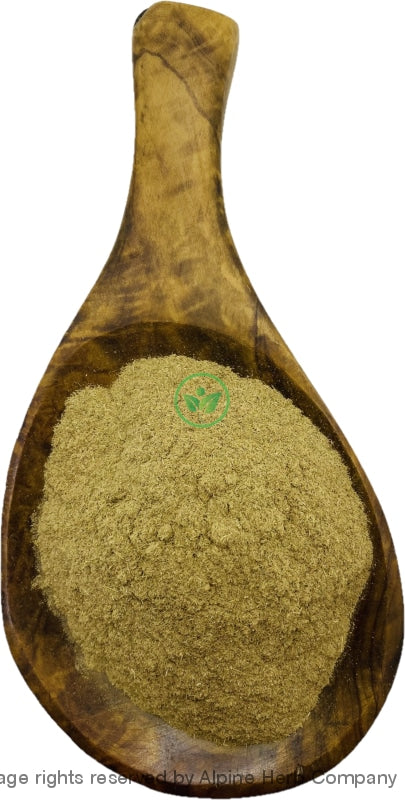Lemongrass Powder Alpine Herb Company Inc.
$ 8,99 $ 5,39
Botanical Name: Cymbopogon citratus
Common Name:
- English: Lemon grass
- Ayurvedic: Bhuutika, Bhuutikaa
- Also, known as: Gandhatrun, Gandhabenaa, Majjigahullu, Hirvaa Chahaa, Olaa Chahaa, Paatichahaa, Gandhatrun, Sharbaan, Nimmagaddi, Vasana gaddi, Vasanaipillu, Chennanampullu, Incippullu, Vasanappullu, Gandhatrun, Harichaaya, Lilichaa, Bhutrnah, Jambiratrnah, Guhybija, Bhutika, Sitroengras, Xiang mao coa, Verveine de Indes, Lemongras, Zitronengras, Sereh, Citronella, Remon gurasu, Serai, Sontol, Takrai, Xa, Capim-cidrao, Capim-santo, Sera, Verveine, Cimbopogone, Sakumau, Zacate limon, Ta-khrai, Limon out, Fever grass, Citroengras, Te limon, Zacate limon, West Indian lemongrass, Cana-cidreira, Cana-limão, Capim-cidró, Capim-santo, Erva-cidreira, Herbe citron, Pasto limón, Patchuli-falso, Verveine des Indes, Zacate limón, Zitronengras, Tanglad, Hierba de limon, Erba di limone, Sera, Bhustrina and Takra.
Habitat: India and Sri Lanka, Egypt
Origin: India
Harvested: Wild or cultivated
Parts Used: Leaves and whole plant
General Information:
Cymbopogon citratus, is a tender perennial of the grass family, grow to 6 ft in height and about 4 ft in width, with a short rhizome and resembles many of its members in the long, upright blades, but with leaves at the ends, and growing in clumps. Lemongrass is a robust perennial tuft with thick stems and broad, bluish-green, aromatic leaves. It is a cultigen that rarely forms flowers. Root are fibrous, adventitious, 5 to 10 mm in length, 0.2-0.5 mm in thickness. Rhizome are irregular, dark brown in color, narrow internodes present 5-9 cm in length, 1-2 cm in diameter. Leaves are glaucous, linear, parallel veined, about 90 cm in length, 2-3 cm in width, conspicuous midrib present, apex pointed like sword, margin entire, with sheathing base and a ligule at its base; lemon odor, taste bitter.
Lemongrass is native to Asia, and thrives in warm and sunny locations and is an essential component of Asian cooking and for essential oil. The flavor is subtle and never dominates. It is particularly well known as a flavor ingredient of “lemongrass soup”. It is used in perfumery, to fragrance skin care products and soaps, and as a flavoring agent in cooking, soft drinks, candy, ice cream, and baked goods. The name Cymbopogon is derived from the Greek words “kymbe” meaning boat and “pogon” meaning beard, referring to the flower spike arrangement.
How to use:
Powdered Herb:
There are different ways to use powdered herb.
Food Preparation: You can add powdered herbs to any super food, herbal smoothie, sauces, spreads and even cookies. Also for children, you can mix powdered herbs with honey or glycerin to make a paste. The thicker the paste, the more potent and herbal in taste. The sweet taste of honey and glycerin will help the medicine go down. This method is also known as “Electuaries”.
Capsules: Encapsulating your own powdered herb at home, give you assurance that the contents of the capsules are pure herb and no filler or any other products. These capsules can be taken with liquid.
Poultice: Poultice can be made with an herbal powder and liquid (mostly water) to form a paste which is then applied to the skin. This method is very helpful for skin conditions.
Herbal shot: Powdered herb can be mixed with water, fruit juice or other liquid to make herbal shot.
Precautions:
You should consult with a qualified healthcare practitioner before using any herbal products, particularly if you are pregnant, nursing, or on any medications.
All information on this website is for educational purposes ONLY.
This information has not been evaluated by Health Canada.
This information is not intended to diagnose, treat, cure, or prevent any disease.
| Unit Size | 100g, 200g, 400g, 1kg |
|---|
Prompt shipping and expert packing
Thanks to our longstanding association with UPS FedEx DHL as well as other leading global carriers, we can offer a variety shipping options. Our warehouse staff is highly trained and will be able to pack your goods in accordance with our precise and exact specifications. Your items will go through an exhaustive examination before they will be securely packaged before being delivered. We ship to hundreds of thousands of customers daily in different countries. This is a sign of our determination to become the largest online retailer worldwide. Warehouses and distribution centers are located throughout Europe as well as in the USA.
Note that orders containing multiple items are processed according to the particular item.
We will thoroughly inspect all items ordered before shipping. Most orders are shipped within 48 hours. The delivery time will be between 3 and 7 working days.
Returns
The stock market is always changing. It's not entirely managed by us since we're involved with several entities, including the factory and the storage. Therefore, the actual inventory could fluctuate at any moment. Please be aware that it is possible that your order could be out of stock after you've placed your order.
Our policy lasts for 30 days. If it's been more than 30 days since the date you purchased your item We're sorry to say that we can't offer you a full exchange or refund.
You can only return a product if it is unused and still in the same state as when you received it. The item should be in the original packaging.
Related products
Herb Powder
Herb Powder
Herb Powder
Herb Powder
Herb Powder
Herb Powder
Herb Powder
Herb Powder
Herb Powder
Herb Powder
Herb Powder
Herb Powder
Herb Powder
Herb Powder
Herb Powder
Herb Powder
Herb Powder


































